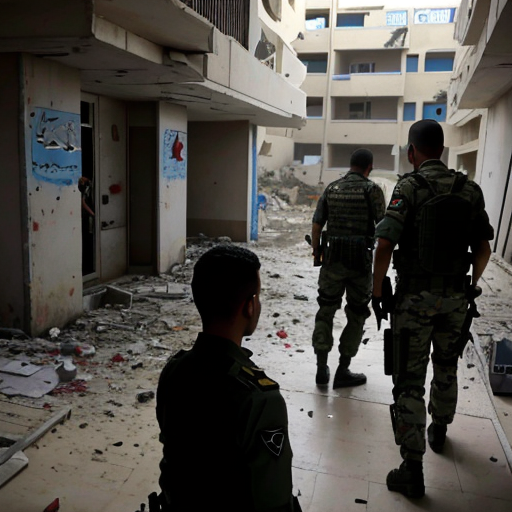14. March 2024
How gunfire and panic engulfed Gaza hospital before Israeli raid

How gunfire and panic engulfed Gaza hospital before Israeli raid
Dr Amira al-Assouli was in Nasser hospital when she heard a man screaming the shahada, the Islamic declaration of faith, right below her window. Video filmed by an onlooker shows her taking off her jacket and running to him with her head low. By the time she reached him, he was dead. The BBC has spent several weeks establishing what happened at Nasser, one of Gaza#39;s biggest and busiest hospitals until an Israel Defense Forces (IDF) raid last month.
On Tuesday, we revealed accusations from medical staff that they were detained, beaten and humiliated by IDF forces during the raid. The BBC has verified footage of 21 incidents of gunfire or its impact filmed from within the hospital grounds. We shared our findings in detail with the IDF, along with questions about its operation at Nasser. Israel has repeatedly accused Hamas fighters of using hospitals and medical centres as hiding places for weapons and command centres.
The IDF says Hamas and other armed organisations have used Gaza hospitals to hide hostages. Hostages who were released during a brief truce in November have given accounts of being locked in rooms there. Sharon Aloni Cunio has said she was taken to Nasser in an ambulance, disguised in traditional Arabic clothes, while her husband, who remains in Gaza, was put under a sheet to look like a corpse. Those we spoke to in the hospital, including international medics who have stayed and worked there since the war began, say there was no overt presence of Hamas fighters they were aware of.
The IDF said some 200 terror suspects had been detained following the raid, including some who had been posing as medics. People in the hospital had little protection from gunfire. We can#39;t stand by the window because if we do, we’ll get shot in the head," says one survivor. It was very difficult times, especially in those last days," says another.
A lot of people tried to save their brothers, relatives, anyone who they knew who was injured. If you want to go to bring someone who#39;s injured inside, it# 39;s like sacrificing or endangering yourself, he says. It’s a very dangerous thing to do," he adds. Nurse Hazim Abu Omar was shot and wounded while on shift inside the operating department.
Footage shared online by a Nasser doctor shows the injured nurse being rushed into an operating theatre. IDF responded that it fired only #34;precise shots at terrorists identified around the hospital complex. Ibrahim Salama was shot in both legs when he went outside to see who was screaming. The pain, he told the BBC, was unimaginable.
In other videos, the buzz of drones can be heard in the sky overhead as people move through the hospital grounds in fear. The BBC has verified footage of dead bodies left to rot on the ground, close to the gate. Dr Harara said bodies could stay in these positions for four or five days, with cats and dogs eating their flesh. The same body can be seen still lying there in a video posted a day later, suggesting no one felt it was safe enough to step out.
The chaos and confusion in Nasser escalated further on 13 February. A handcuffed man dressed in a white jumpsuit with a piece of yellow fabric tied around his head entered the complex with orders for people to leave. He was identified to the BBC by people at the hospital as Jamal Abu al-Ola, a Palestinian man who had disappeared a day earlier. Doctors at Nasser reported more shootings within the hospital grounds on this day.
Dr Khaled Serr posted on Instagram saying that two boys had been shot while playing. In a voicenote from the time, he said three civilians were shot in front of the hospital gates. The IDF did not respond to BBC questions about Jamal#39;s death. Photos of each of the boys Dr Serr said were shot while playing match posted on the same day by a journalist who was in the complex at the time and verified by the BBC.
We cannot independently confirm the circumstances of the shootings. A tank knocked down part of the wall surrounding the Nasser complex. Orders for people to leave were made over loudspeakers on Israeli military vehicles. Ibrahim escaped through an Israeli checkpoint.
He says he saw many people around him being detained. A shell hit the orthopaedic department, killing one person, according to the hospital#39;s general manager, Atef al-Hout. The IDF said a #34;stray shell#34;" had been fired towards a military target nearby and had accidentally hit a building inside the hospital. Video shows medics pulling the injured from a room reduced to rubble.
In another video, a group of men - some of whom are wearing medical scrubs - flee when one steps into the street and comes under fire. In a later fragment of video, she is seen lying in the back of a car being driven away. Among those who remained at the hospital were patients who could not move, displaced people with nowhere to go, and medics who felt duty-bound to stay. Those who remained describe surviving on limited food and water, performing ablutions, or cleansing before prayers, using the fluid from medical drips and living in cramped and unsanitary conditions.
Medics forced to strip and kneel with their hands behind their heads. They feared being shot if they returned to the yard. Two days later, the World Health Organization declared Nasser was no longer functional. The IDF said it provided the hospital with food rations and an alternative generator.
When the BBC visited the hospital this week, the wards only recently teeming with patients stood empty. Only a few displaced people were on its grounds. They are hungry. They need anything [they can get],#34; said Dr Hatem Raba.